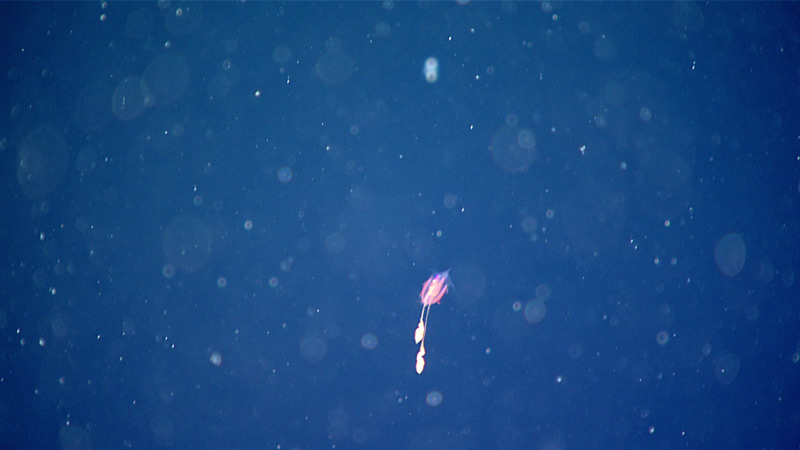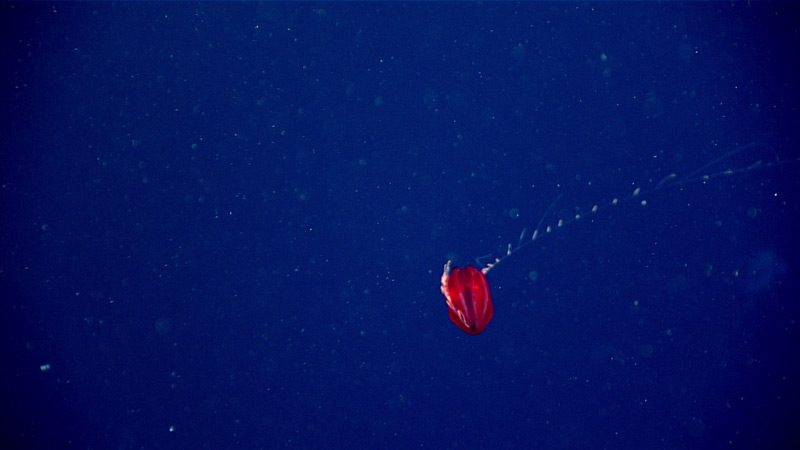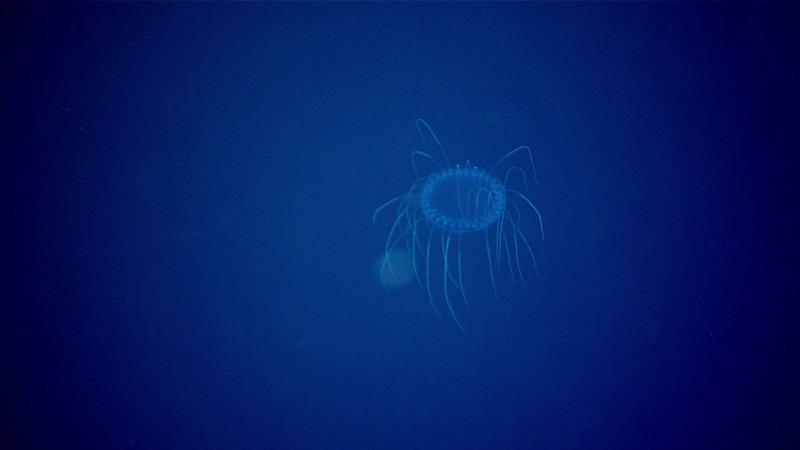
Quinn L. Girasek, NOAA Hollings Scholar, NOAA Ocean Exploration
Seen during the 700-meter (2,297-foot) water column exploration tract of Dive 20 of the 2021 North Atlantic Stepping Stones expedition, this beautiful red jellyfish in the genus Poralia may be an undescribed species. Video courtesy of NOAA Ocean Exploration, 2021 North Atlantic Stepping Stones: New England and Corner Rise Seamounts Download largest version (mp4, 64.4 MB).
During the 2021 North Atlantic Stepping Stones expedition, I participated as a scientist from shore with NOAA Ocean Exploration as part of my Ernest F. Hollings Scholarship Program internship this summer. This included participating through the science teleconference line and chat room. It was very exciting talking to people watching the livestream from their homes across the globe! As a Hollings intern, I am conducting research to further our understanding of previously unexplored ocean habitats. My project this summer focuses on the abundance of organisms within the mesopelagic, or twilight zone (200-1,000 meters/656-3,281 feet depth) in the Atlantic Ocean around the Gulf Stream and within the deep scattering layer. To do this, I am using data from 2018 and 2019 NOAA Ocean Exploration dives (e.g., Oceano Profundo 2018 and Windows to the Deep 2018 and 2019).

Quinn Girasek, NOAA Hollings Scholar with NOAA Ocean Exploration, at her monitors annotating organisms in the water column seen during Dive 20 of the 2021 North Atlantic Stepping Stones expedition. Image courtesy of NOAA Ocean Exploration, 2021 North Atlantic Stepping Stones: New England and Corner Rise Seamounts. Download larger version (jpg, 2.4 MB).
My role during this expedition was annotating the water column dive, which took place on July 28, 2021. The annotations were added into SeaTube , an electronic database run by Ocean Networks Canada. Using SeaTube, I was able to watch the dive live and annotate when an organism was spotted. The site is integrated with the World Register of Marine Species (WoRMS ), which means after saving the annotation, a hyperlink to the identified organism in WoRMS shows up. The times are coordinated with the dive so anyone viewing the dive can see what organisms they’re looking at. Notes are also added to annotations for record keeping and to allow scientists to go back and see more than just the taxonomic information.
During dives, remotely operated vehicle Deep Discoverer uses a robotic arm or suction sampler to pick up a limited number of specimens and place them in one of five collection jars, which are able to store organisms. I made notes of which organisms were sampled and after the dive was over, I went into SeaTube and added the collection timestamps in the notes section. I also took notes of potentially new and/or undescribed species. That was definitely a highlight and I can’t wait until we learn more about those organisms! If you go into SeaTube and filter by the words “collect” and “new” then you’ll be able to go directly to the portions of the videos where we saw those organisms. Besides the viperfish, two of my favorites from this dive are the ctenophore, genus Vampyroctena, and the cnidaria, genus Solmissus.

During Dive 20 of the 2021 North Atlantic Stepping Stones expedition, scientists were able to identify this undescribed ctenophore, or comb jelly, as belonging to the order Cydippida. It was seen during the 1,200-meter (3,937-foot) dive transect. Image courtesy of NOAA Ocean Exploration, 2021 North Atlantic Stepping Stones: New England and Corner Rise Seamounts. Download larger version (jpg, 350 kb).

This red ctenophore in the genus Vampyroctena was seen at a depth of 700 meters (2,297 feet) during Dive 20 of the 2021 North Atlantic Stepping Stones expedition. Image courtesy of NOAA Ocean Exploration, 2021 North Atlantic Stepping Stones: New England and Corner Rise Seamounts. Download larger version (jpg, 321 kb).

This jellyfish in the genus Solmissus was collected during Dive 20 of the 2021 North Atlantic Stepping Stones expedition at a depth of 900 meters (2,953 feet). Image courtesy of NOAA Ocean Exploration, 2021 North Atlantic Stepping Stones: New England and Corner Rise Seamounts. Download larger version (jpg, 321 kb).
After the water column dive I also contributed to the scientific dive summary. This summary lists information on the organisms collected and any interesting behaviors observed. This document will be published to the NOAA Institutional Repository and incorporated in the expedition report. Both of these pieces will be available on the NOAA National Centers for Environmental Information website.
Overall, a variety of animals were seen, like ctenophores, cnidarians, crustaceans, and Actinopterygii (ray-finned fishes). We also saw several undescribed families and potential new species. It was great to get to know the experts through the science chat room. Everyone was friendly and funny. I personally enjoyed the Olympics-related jokes and the excitement about the new jellyfish. I truly enjoyed my time with NOAA Ocean Exploration and will never forget this amazing opportunity. I am very grateful for everyone who supported me thus far.
Published August 4, 2021